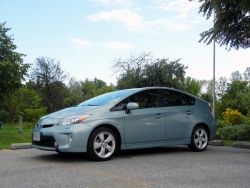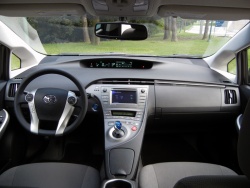 2012 Toyota Prius. Click image to enlarge |
| Comparison: Best fuel-efficient cars Test Drive: 2012 Chevrolet VoltManufacturer’s web site Toyota Canada |
Review and photos by Jonathan Yarkony
Photo Gallery:
2012 Toyota Prius
The Toyota Prius is a well-known commodity at this point. Incredibly efficient motoring from a battery-powered electric motor and gasoline internal combustion engine wrapped up in a package you will not soon mistake for a ‘normal’ car. However, as hybrids from other companies become more popular, and conventionally powered cars adopt more and more of the Prius’s aerodynamic tricks, it is a shape that is becoming both familiar and commonplace.
While much of the attention of late has been on the newly launched Prius V wagon, Prius C subcompact hatch, and Prius PHV plug-in hybrid, the 2012 Prius (which you can call the Prius liftback if you’re uncomfortable calling it simply Prius) received a mid-cycle update, including a facelift with new headlamps, grille, front bumper and rear combination lamps and an updated interior, along with new standard or optional equipment.
 2012 Toyota Prius. Click image to enlarge |
For the 2012 model year, Toyota also dropped the starting price to $25,995, almost two grand cheaper than the 2011 model, and still packed in more base features while updating the styling. The styling is very mildly progressive, with more sculpted headlights and angular front end, but it does manage to look a touch more athletic for its lumpy shape.
But the Toyota Prius didn’t become the global ‘face’ of hybrids just because it looks weird. It delivers exactly what it promises—incredibly low fuel consumption, even in the most demanding driving conditions.
As has been reported by many owners I’ve questioned, 5.0 L/100 km is an entirely realistic combined fuel economy figure, and that is exactly what we achieved in a week of commuting on one of the world’s worst stretches of stop-and-go highway traffic: Highway 401 through the Greater Toronto Area.
While the Prius delivers the fuel efficiency goods, it does take some adjustments to drive it smoothly. As with most hybrids (and now in many non-hybrids), free electrons are collected from the brake rotors in order to recharge the battery. It is not a significant amount of braking force, but you can feel a slight tug as soon as you get off the gas, which is the feel of the regen brakes capturing braking energy to keep the battery well charged. And when you add brake pedal pressure, it comes to a stop in a sudden, jarring fashion, until you get used to it.
 2012 Toyota Prius. Click image to enlarge |
The battery powering the Prius’ 60-kW electric motor (80 hp) is a Nickel Metal Hydride (NiMH) battery pack providing 27 kW output at 201.6 volts. The chief advantages of NiMH batteries are their proven stability and affordability—they cost far less to produce in the sizes needed for automotive application than Li-ion. However, NiMH batteries are, on average, heavier for equivalent power storage than Li-ion.
Acceleration is slow and smooth in the Prius and it is almost impossible to tell when the 1.8L gas engines fires up and when the car switches back to electric power. The direct-injection engine contributes 98 hp and 105 lb-ft of torque to the cause, and the combined gas-engine/electric motor output is rated at 134 hp, routed to the front wheels through a CVT transmission. You can get a bit more oomph in a driver selectable Power mode, but really, just accept the slowness, try to keep it in EV mode as long as possible, and drive at its pace—that will also yield the best fuel economy. It can cruise comfortably at 120 km/h, although the small engine is a bit whiny at that speed, and everything just seems more natural and comfortable at 100–110 in this car.
Many complain that the Prius handles no better than an average shopping cart, but I think it handles credibly for its purpose. I never even contemplated exploring its limits, and don’t really care how soon it understeers or whether it is vague when pushed beyond speed limits around onramps. I highly doubt most owners would either.
   2012 Toyota Prius. Click image to enlarge |
It is stable, quiet, and comfortable on the highway, but excels in tight confines, where its compact footprint and light, quick steering make it an excellent city car. It is also a cinch to park, except for the weird split rear window because of the aerodynamic liftback design. Thankfully, the Prius comes with a standard backup camera, so that’s a wash.
Other standard features on a base Prius are Bluetooth phone connectivity, USB jack, keyless entry with push-button start, auto climate control, and cargo capacity of 445 L with 60/40 slip folding rear seats for more flexible space. One surprise we noted was that the Prius handled a six-foot ladder with more room to spare for the front-seat passenger than a Mazda CX-5. More convenience features that come as standard equipment are: auto up/down windows, Eco Drive monitor with fuel economy gauge, illuminated vanity mirrors, tilt and telescopic steering wheel with “Touch Tracer” controls, all-season floor mats, cargo cover, map lights, heated mirrors, variable intermittent wipers, intermittent rear wiper, and automatic headlamps.
The Moonroof Package, at $29,245, adds a nav system, XM satellite radio, integrated garage door opener, foot well lighting, passenger front door touch unlock sensor, remote air conditioning, and illuminated front door sills. The moonroof package features a power, um, sunroof with solar panels, whose solar panels power a ventilation fan while the car is parked.
Our $29,550 Prius Touring ($31,220 with $1,565 destination and $100 A/C Tax in) included a nav system, satellite radio, fog lamps, 17-inch alloy wheels, LED headlamps, and extended Bluetooth adding phonebook and streaming audio.
The fully loaded Prius with Technology Package takes the price up to $34,080 before destination and taxes and adds premium JBL eight-speaker audio, 7-inch display with Navigation, pre-collision system, heated synthetic leather seats, eight-way power adjustable driver seat, water-repellent front door glass, dynamic radar cruise control, and Intelligent Parking Assist.
 2012 Toyota Prius. Click image to enlarge |
Each of the upgraded models is at least $2,000 less than the equivalent 2011 models, making the Prius a more competitive product against non-hybrid competitors
If there was one thing we would improve, it is the interior materials. While the Prius is pioneering Eco-plastic—plastics derived from plants—those are not the reason for acres of tinny, tacky plastic everywhere; those are just cheap materials to offset the cost of the advanced powertrain. Some drivers also found the central gauges disorienting and difficult to adapt to, but that might just be the adjustment period—I found them highly visible and clear.
The Prius doesn’t need any defenders; it sells both as a practical, efficient compact car, and as a rolling symbol of energy efficiency and clean emissions. And while some drivers might never be able to give up their desire for an involving driving experience, the Prius entertains with its own unique brand of eco-accomplishment rewards that engages the mind more than the seat of your pants.
Price: 2012 Toyota Prius
Base price: $25,995
Options: $3,555 (Touring Package: navigation, satellite radio, integrated garage door opener, fog lamps, 17-inch alloy wheels, auto-levelling LED headlamps, headlamp washers, passenger door handle touch sensor lock/unlock, and extended Bluetooth adding phonebook and streaming audio)
Freight & PDI: $1,565
A/C Tax: $100
Price as tested: $31,220
Specifications
2012 Toyota Prius
Competitors
2012 Chevrolet Volt
2012 Honda Insight














